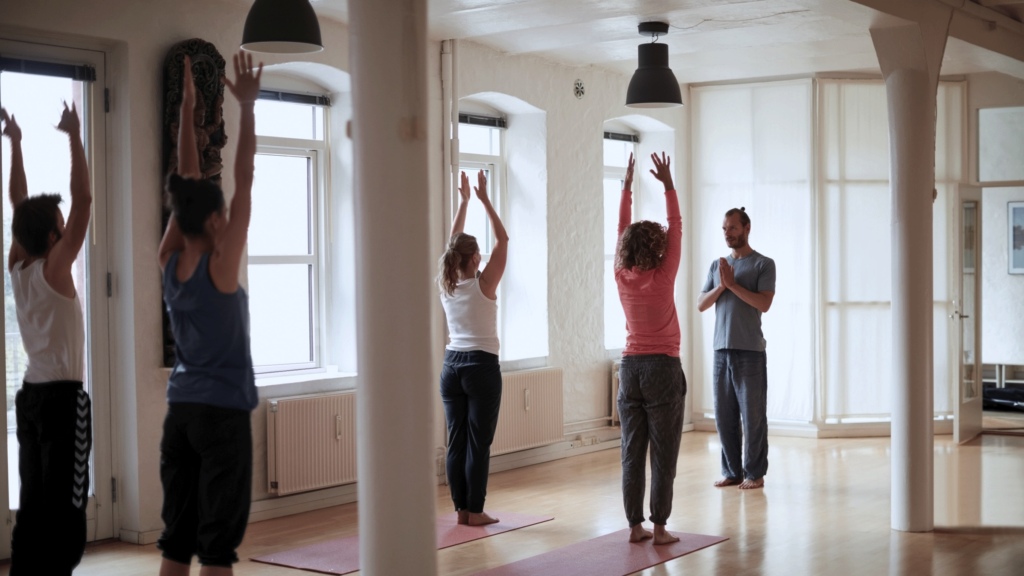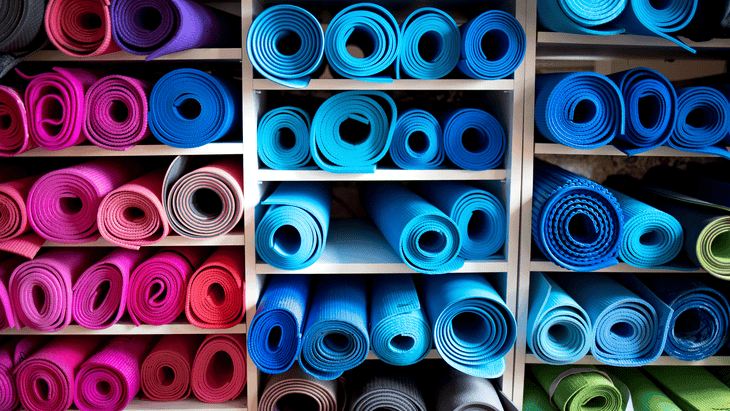
“], “filter”: { “nextExceptions”: “img, blockquote, div”, “nextContainsExceptions”: “img, blockquote, a.btn, a.o-button”} }”>
Heading out the door? Read this article on the new Outside+ app available now on iOS devices for members!
>”,”name”:”in-content-cta”,”type”:”link”}}”>Download the app.
When you step into a yoga studio and catch a whiff of chemical cleaners, it can be hard not to feel a little betrayed. After all, yoga is meant to help you explore the interconnectedness of your practice with life on the planet. So when the scent of synthetic chemicals fills these sacred spaces, it can be disconcerting.
Some yoga studios have invested in holistic environmentalism in recent years by implementing eco-friendly and sustainable practices. That includes waste-reduction measures such as going paperless, using energy-efficient lighting, and yes, natural cleaning products.
Behind the scenes, and in ways that are sometimes less obvious but still significant, other studio owners and managers find themselves doing what they can to lessen their carbon footprint but constrained from taking larger measures by financial realities or limited local resources. Becoming a fully eco-friendly and sustainable studio may be easy to talk about as an aspirational issue of priorities, but making it happen often isn’t related to willingness but workability.
Eco-Conscious Innovations
Eco-friendliness and sustainability—specifically, avoiding the overuse of natural resources—is inherently yogic. Though Patanjali never outlined recycling standards in the Yoga Sutra, many practitioners consider sustainability to be a contemporary application of ahimsa, or non-harming. By reducing our consumption of resources, we minimize our harm to the planet.
Yoga is also a practice of awareness—of yourself and your interrelationship with others and the world around you. Since ahimsa and awareness are foundational teachings of yoga, many students and teachers consider eco-consciousness to be a responsibility of yoga studios.
India-based yoga teacher trainer Gis George recently wrote about the topic, explaining, “When studios implement eco-friendly practices and share their experiences, they encourage others to follow suit.”
Yoga teacher Jean Moore did exactly that. She drew on her knowledge as an architect to supercharge Asana Yoga, the studio she co-founded in Oakland, California in 2013. Her professional accreditation in Leadership in Energy and Environmental Design (LEED) enabled her to design the studio with bamboo flooring, thermoregulatory R-31 insulation, reclaimed windows, low-flow sinks and toilets, low-wattage LED lighting fixtures, and exterior signage made from corn products.
Moore was able to realize her vision of a sustainable, functional, and beautiful space. Unfortunately, along with so many studios, it closed permanently in late 2020. Still, Moore’s green-certified space is an inspiring example of what’s possible in the realm of environmentalism in yoga studios—and what some studios have already achieved.
The Sustainability Struggle
In practical terms, eco-conscious goals for yoga studios must first filter through the inescapable lenses of accessibility and financial feasibility.
One major hurdle in creating green spaces like Moore’s Asana is that a large number of studio owners rent their spaces, limiting their ability to undertake extensive renovations or make structural changes. Those who rent rather than own can also face challenges related to smaller sustainability efforts, such as the building not providing recycling or composting.
Even for those who own their studio’s building, embarking on such renovations can be highly disruptive to the class schedule, often necessitating closures that impact revenue streams.
Moreover, green initiatives can be financially taxing for businesses that already operate within tight profit margins, as the costs of renovations, equipment upgrades, and regulatory compliance is significant.
For larger corporations, the issue of embracing sustainability may be inherently logistical, with sprawling managerial systems needing help to organize the upgrades effectively. For corporations and independent studio owners alike, local resources and availability may also be a hurdle.
When yoga teacher and entrepreneur Brytta Moreira moved back to Lisbon after spending years in the states, she found the green options in the EU were limited. The exorbitant shipping and tariffs of imported goods—such as cork blocks and natural rubber mats—make them too costly for Moreira to integrate into her teaching.“Portugal doesn’t have many options for mats and props, let alone sustainable mats and props,” she says. “If we had more options, we could be more sustainable.”

Another common issue is balancing energy efficiency with the desire for students’ and teachers’ warmth and comfort. When the studio is slightly above room temperature, says Moore, many students find it easier to relax mentally and become more physically able to stretch. If a studio is too cold, students won’t come to class and teachers won’t teach. Saving energy by limiting heating affects business.
Perhaps most concerning is the effectiveness of natural cleaners in high-traffic settings. Some studio managers worry that natural cleaning alternatives, such as vinegar or tea tree oil, might not sufficiently combat germs and maintain hygiene standards, especially in studios bustling with practitioners building up a sweat after heated vinyasa flow.
In 2016, researchers from Concordia University examined the efficacy of essential oil-based cleaners against the growth of Staphylococcus aureus (MRSA), a notorious bacterium known for causing staph infections, on yoga mats. The study focused on three specific cleaning solutions: two commercially available products and a third product produced in the laboratory with a recipe for a popular DIY solution including essential oil. Despite being marketed as all-natural and effective for cleaning yoga mats, all three products were found to be ineffective in combating the growth of harmful bacteria.
“We make a concerted effort to use as many eco-friendly products as possible,” says Metro-Midkiff. “However, it is very challenging to find products, specifically in bulk sizes, that are effective in a busy studio.”
“We are always at odds with the housekeeping staff about the products that we use,” she adds. “We prefer to use eco-friendly products, while they prefer us to use products that are more ‘effective.’ There always seems to be some kind of disappointing compromise.”
Moving toward a more environmental studio can take time…and it certainly takes effort. “Our staff and teachers are definitely committed to finding more sustainable resources for our studio, and so it is a discussion that is always ongoing,” says Radha Metro-Mitkif, executive director for the Integral Yoga Institute New York.
Yet not everyone understands that. “Because we are yoga studio owners, we must be sustainable, or expected to be that, right away,” says Moreira.
7 Strategies to Move Toward Eco-Friendly Yoga Spaces
Despite the obstacles, many yoga studios are finding creative ways to incorporate more earth-friendly practices into their operations.
Amanda McCarroll, co-owner of Buddhi Moves yoga studio in La Jolla, California, keeps her efforts simple and streamlined. “We don’t think you have to spend a bunch of money to be eco-friendly,” she says. “(You) can make small changes to create sustainability over time.”
From community-driven initiatives to prioritizing local vendors, the unique approaches taken by McCarroll and others illustrate that sustainability can be as much about mindset as resources.
1. Reduce Single-Use Items
Many studios have already converted their bookkeeping and scheduling systems to digital. Moreira encourages studio owners and managers to consider shifting sign-ins, advertising and all other aspects of operations to digital as well. “We are entirely paperless, so everything about the studio’s business side is run online,” she says.
She also suggests committing to sustainable toilet paper and paper towels and replacing single-use paper towels with cloth towels, opting instead to incur the laundry it creates.
To minimize plastic water bottle use, McCarroll encourages students and teachers to bring their own water bottles and install a water station. “If you do provide cups, make sure they are compostable,” she says.
2. Opt for Local Vendors
Sourcing products locally not only reduces a product’s carbon footprint by eliminating shipping but also contributes directly to the livelihoods of businesses and individuals within your community. If your budget allows, prioritizing local sourcing can be a meaningful way to align your business practices with environmental sustainability and community support.
3. Encourage Less-Obvious Sustainability Measures
There are less obvious ways to inspire eco-consciousness among students and teachers. Moreira touts the success of her studio’s regular clothing swaps as one of her proudest sustainability initiatives. Every month, she invites women in the Lisbon community to the studio where they can trade clothing, shoes, and accessories. She donates any items left behind to local thrift stores. It’s an entirely free, outside-the-box initiative.
4. Minimize Lighting (or Don’t Use It At All)
LED (light-emitting diode) bulbs are widely regarded as the most efficient type of light bulb available. They consume significantly less energy than traditional incandescent bulbs and even outperform CFLs (compact fluorescent lamps) in terms of energy efficiency and longevity, so moving toward sustainability can be as simple as changing a lightbulb.
Alternatively, Moreira takes a fully natural approach to lighting. “We don’t use lights in the studio as there is no need,” she says. “During the night, we light candles because it makes the experience cozy and soothing for our students. Plus, we have the moonlight for extra lighting if needed.” Studio owners: Take heed of fire codes and safety issues.
5. Engage Volunteers
Another less obvious approach to affording sustainability is to save payroll hours that staff would spend cleaning and instead invite volunteers or community members to give back to the studio space.
“One thing that we do is have Karma yoga or volunteer days to clean the bigger spaces in our studio,” Metro-Midkiff says. With limited resources, we definitely utilize volunteers to help support us.”
This could allow you to instead spend that budget on more sustainable light bulbs, cleaning solutions, or studio upgrades.
6. Rely on Sustainable Team Members
Moreira suggests hiring front desk team members with educational degrees or experience related to environmental consciousness. “Give them tasks around their passion for sustainability while teaching them how to run a yoga studio,” she says. “This way, everyone is growing and passionate about their work.”
7. Move Away from Plastic Mats and Props
In line with a commitment to sustainability, Metro-Midkiff has moved away from providing foam blocks at her studio and replaced them with cork blocks. She has also switched to mats made from biodegradable materials. Though this can be costly, she considers it a meaningful investment.
8. Be Patient
Yes, there are myriad ways to make your studio more sustainable, but don’t let overwhelm, indecision, and assumptions about cost trick you into complacency. Start small.
“My advice would be to pick one or two areas to start with that can have the most impact,” says Metro-Midkiff. Consider what would make the most significant change for the studio, taking into account your budget and needs.
Additionally, give yourself and your team the time to navigate these changes. “A yoga studio is a business like any other industry,” Moreira says. “Sustainability systems take time to implement.”
McCarroll notes that it helps to keep a calm and agreeable attitude as you make shifts toward a more sustainable operation. Whether you’re explaining a change to frustrated individuals or listening to someone’s suggestion as to how you could do things “better,” a defensive or dictatorial attitude can alienate staff and students.
Perhaps most important is an attitude of celebrating the changes that have already been initiated while acknowledging that there is always more that can be done.









